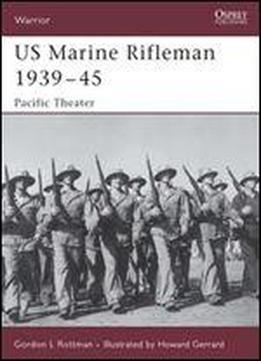
Us Marine Rifleman 193945: Pacific Theater (warrior)
by Gordon L. Rottman /
2006 / English / PDF
3.2 MB Download
Osprey's study of United States Marine Corps riflemen during World War II (1939-1945). It is sometimes a basic assumption that a US Marine Corps rifleman was essentially trained, uniformed, equipped, and armed much the same as a US Army rifleman during World War II. While there were of course similarities, the Marines conducted their own unique training programs, wore mostly different uniforms and equipment, and possessed some unique weapons, although they also used many of the same weapons as the Army.
The Marine Corps was not part of the Navy, but a component of the Navy Department alongside the Navy. While the Marines specialized in amphibious warfare, the Army actually conducted more amphibious assaults in the Pacific than the Marines. The typical Marine was extremely proud of his service and acutely aware that there were only six Marine divisions but 89 Army divisions. The Marine Corps began World War II with less than 66,000 officers and men more than that would be wounded before it ended. The Corps grew to almost 487,000. It provided only 5 percent of the US armed forces, but suffered 10 percent of overall American casualties.
The Marines were able to build on their proud traditions and history to transform a small branch of service into a premier combined arms amphibious assault force. Regardless of its expansion by 750 percent, the Corps was able to maintain its sense of tradition, instill that into thousands of new Marines, and create an elite arm of service. Here, Gordon L Rottman, follows the Marine rifleman through his draft and training, and then participation in operations such as Roi-Namur in the Marshall Islands, Saipan and Tinian in the Mariana Islands, and Iwo Jima.
The opening sentences of the Marine Creed, composed shortly after the attack on Pearl Harbor
This is my rifle. There are many like it, but this one is mine. It is my life. I must master it as I must master my life. Without me my rifle is useless. Without my rifle, I am uselessThe Marine Corps began World War II with less than 66,000 officers and men. Yet despite suffering 10 per cent of the overall American casualties, the Marines were able to build on their proud traditions and history to transform a small branch of service into a premier combined arms amphibious assault force. Regardless of its expansion by 750 percent, the Corps was able to maintain its sense of tradition, instill that into thousands of new Marines, and create an elite arm of service. In this book, Gordon Rottman, follows a Marine Corps rifleman through his draft, training and participation in assaults such as: Roi-Namur in the Marshall Islands, Saipan and Tinian in the Mariana Islands, and Iwo Jima.











